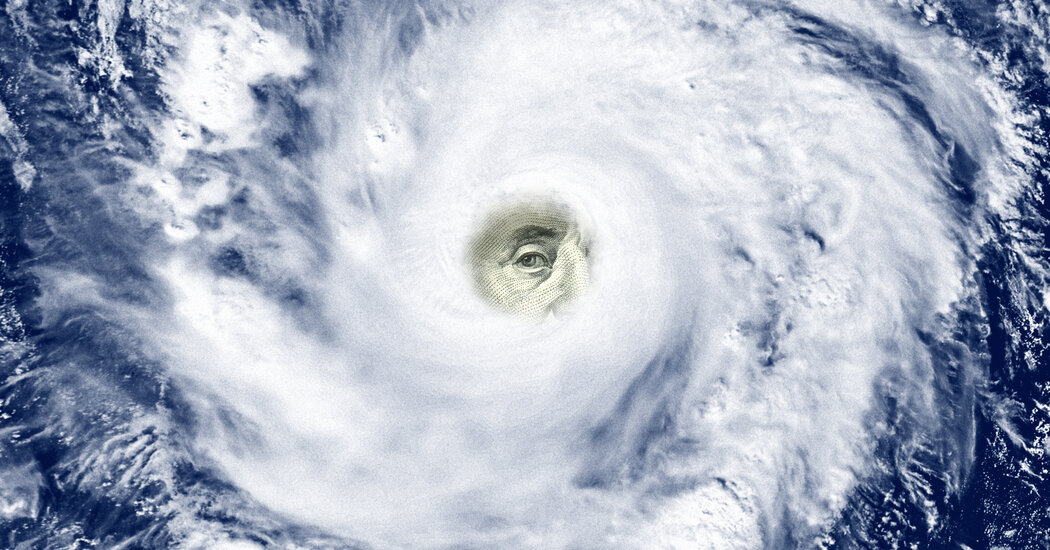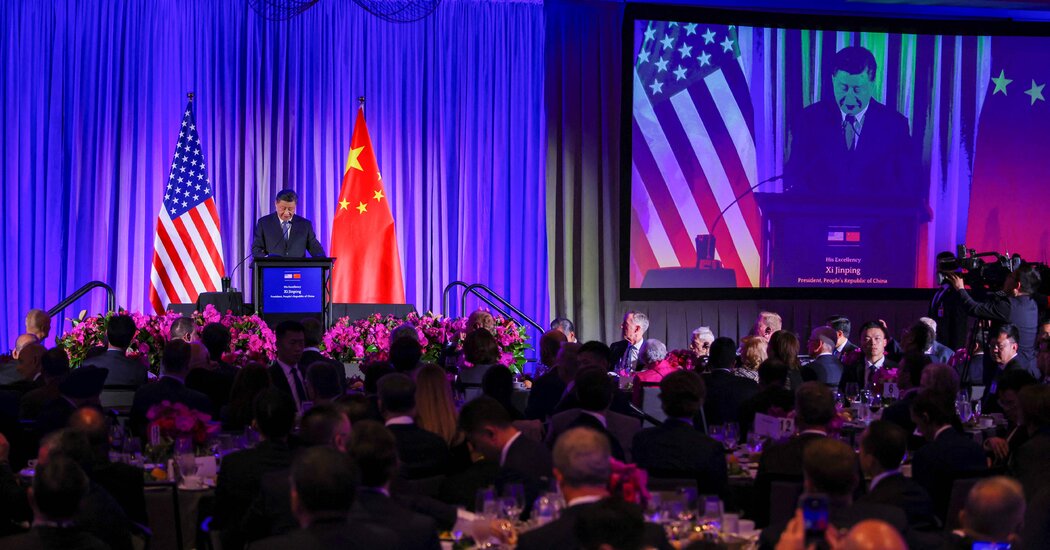June 3, 2024 | by Kaju

Southern California gave the impression to be below siege from a blockade.
Greater than 50 huge vessels bobbed within the frigid waters of the Pacific Ocean, marooned off the dual ports of Los Angeles and Lengthy Seaside, Calif. As days stretched into weeks, they waited their flip to drag as much as the docks and disgorge their cargo. Rubberneckers flocked to the water’s edge with binoculars, making an attempt to depend the ships that stretched to the inky horizon.
This was no act of conflict. This was what it seemed like when the worldwide financial system got here shuddering to a halt.
It was October 2021, and the planet had been seized by the worst pandemic in a century. Worldwide commerce was rife with bewildering dysfunction. Primary geography itself appeared reconfigured, as if the oceans had stretched wider, including to the space separating the factories of China from the superstores of america.
Given the dimensions of container ships — the most important have been longer than 4 occasions the peak of the Statue of Liberty — any single vessel held at anchor indicated that giant volumes of orders weren’t reaching their meant locations. The decks of the ships have been stacked to the skies with containers loaded with the elements of up to date life — from clothes and electronics to drums stuffed with chemical substances used to concoct different merchandise like paint and prescription drugs.
Among the many ships held within the queue was the CSCL Spring, a Hong Kong-flagged vessel that was carrying a whopping 138 containers from Yihai Kerry Worldwide, a serious Chinese language agricultural conglomerate. Collectively, they held 7.3 million kilos of canola meal pellets — sufficient animal feed to maintain 20,000 cows for every week. Their delay was exacerbating shortages of feed afflicting livestock producers in america.
5 ships on this waylaid flotilla have been collectively hauling 13 million kilos of Fiji bottled water. Greater than 17 million kilos of Heineken beer was held up. The Singaporean-flagged Wan Hai 625 was carrying nearly three million kilos of polyethylene terephthalate resin, a key ingredient for manufacturing artificial materials and plastic bottles used to bundle tender drinks — one other commodity in brief provide. The identical ship held 5.2 million kilos of photo voltaic panels and 1.6 million kilos of fabric for chain-link fencing.
By one estimate, the ships ready off Southern California’s two largest ports have been collectively loaded with greater than $25 billion value of products. And this was a fraction of the wares stranded by a worldwide breakdown that had reached staggering proportions. Almost 13 % of the world’s container delivery fleet was floating off ports from China to North America to Europe. Upward of $1 trillion value of product was caught within the congestion.
All of these things was speculated to be someplace else.
However the docks have been overwhelmed by an inflow of containers as People caught in quarantine outfitted themselves for the apocalypse, filling their basements with train bikes, their bedrooms with workplace furnishings and their kitchens with baking tools. Most of those items have been manufactured in Asia. The trucking trade complained that it couldn’t rent sufficient drivers to maneuver this tsunami of product. Warehouses have been stuffed to the rafters and in need of employees. The railroads — hollowed out by years of company value slicing — have been buckling within the face of a surge of demand.
For many years, the world had appeared compressed, the continents bridged by container ships, web hyperlinks and exuberant religion in globalization. Now, the earth once more felt huge.
——
Within the middle of the pileup off Lengthy Seaside lay the Maersk Emden, a Danish-flagged container ship that stretched 1,200 ft lengthy and 158 ft broad. Freshly arrived from the Chinese language port of Ningbo, it was carrying roughly 12,000 containers.
Hagan Walker had just one field on board the Maersk Emden — a 40-foot container logged within the delivery manifest as MSMU8771295. Nevertheless it held an important order within the transient historical past of his start-up.
Mr. Walker’s firm, Glo, was primarily based in a small city in Mississippi. It made plastic novelty cubes that lit up when plunked in water. He had lately secured a breakthrough deal — a contract to make bathtub toys for Sesame Road, together with a figurine model of the long-lasting Elmo. He had deliberate to debut them throughout the pivotal vacation season, now solely two months away.
Like tens of millions of corporations, Mr. Walker’s operation trusted two essential components: factories in China to make its merchandise and gigantic container ships to hold them to American shores. For many years, this had proved an inexpensive and dependable option to do enterprise, the means by which main manufacturers and area of interest gamers alike had saved the world’s largest financial system stocked with every little thing from oven cleaner to plane components.
However that equation was unraveling, and Mr. Walker discovered himself confronting the mom of all site visitors jams off the coast of Southern California.
Because the calendar continued its relentless march towards the vacation season, his Elmo dolls have been floating out on the water, castaways throughout the Nice Provide Chain Disruption.
By the point the Maersk Emden joined the floating queue off Lengthy Seaside bearing Mr. Walker’s cargo, folks from Europe to Africa to North and South America had endured a terrifying shortage of non-public protecting gear like face masks and medical robes. This had compelled frontline medical employees to take care of sufferers with Covid-19 absent satisfactory safety.
Society had skilled the disappearance of bathroom paper from retailer cabinets amid panicked hoarding. Ladies’s sanitary merchandise had grow to be tough to search out, together with medicines like antibiotics and even aspirin. Meat show circumstances at supermarkets sat empty. For a time, Grape-Nuts, the favored breakfast cereal, all however vanished, together with the tapioca beads used to make boba tea.
Factories in Asia that manufactured laptop chips couldn’t hold tempo with a considerable improve in demand, an emergency in an age during which chips had grow to be the brains for all method of units. Auto factories from Japan to america to Brazil halted manufacturing, citing a scarcity of chips. American automobile sellers sometimes held two to 3 occasions as many automobiles as they bought in a month. By the top of 2021, their stock had plunged to a document low — lower than half their quantity of gross sales. And as new automobiles turned scarce, the costs of used automobiles exploded.
Medical system producers launched into a largely futile marketing campaign to disgrace chip corporations into prioritizing their orders over these from smartphone corporations like Apple and Google. Main electronics corporations started covertly shopping for outdated toys and video gaming consoles, breaking up historic PlayStations and Barbie equipment to reap the chips inside.
For shoppers who by no means beforehand had purpose to ponder the intricacies of the worldwide provide chain, all of this was cosmically disconcerting. The shortages of products conveyed a gut-level affirmation that modern life itself had gone haywire, exposing a darkish and unsettling fact: Nobody was in management.
In rich international locations, society had been steeped in the concept that the web had transcended the normal constraints of time and house. You can go browsing at any hour, on any day, regardless of the climate, click on right here, after which await the truck to reach together with your order.
In a world stuffed with grave uncertainty, right here was a certain factor.
The availability chain was not simply the circulatory system for items, but in addition the supply of a way of authority over human circumstance, and a uncommon unifying facet of contemporary existence. In a time of flagging religion in authorities, skepticism about information media and suspicion of company motives, everybody might at the very least consider within the unseen forces that introduced the UPS man to the door. The hyperlinks connecting farms, factories and distribution facilities to households and companies had appeared inviolate.
As the availability chain started fraying, city actuality from Minneapolis to Milan was dominated by the ceaseless wailing of ambulances hauling these stricken with Covid-19 to hospitals, the place folks have been dying on gurneys stashed in corridors, the rooms overflowing, the availability of ventilators exhausted. From San Francisco to Stockholm, folks have been taking their final breaths alone in nursing houses, with out saying goodbye to their kids and grandchildren. Every single day introduced grim reviews of a rising tide of dying that ultimately took the lives of practically seven million folks worldwide.
——
Over latest many years, multinational corporations from North America to Europe to Japan had positioned their destiny in a ruthless form of effectivity. That they had steadily entrusted manufacturing to factories across the globe, and particularly to vegetation in China, chasing decrease prices and fatter income.
And so they had behaved as if this technique was devoid of threat, as if China’s industrial parks would possibly as nicely have been extensions of Ohio and Bavaria. They both didn’t know or didn’t care that the delivery trade was mainly a cartel, working largely past the oversight of any authorities watchdog.
As soon as their merchandise reached American shores, corporations relied on transportation networks that trusted tens of millions of employees who submitted to harmful and lonely jobs, at the same time as their pay and dealing situations have been downgraded. In developing a provide chain ruled by the relentless pursuit of effectivity, trucking and railroad companies handled their employees as if their very own time was each limitless and with out worth, deserving of no compensation for hours caught ready for the following load.
From the railroads to trucking corporations to warehouses, main corporations within the provide chain had lengthy handled their employees as prices to be contained slightly than human beings with households, medical challenges and different calls for. Employers assumed that they didn’t have to fret about working out of laborers, at the same time as they engaged in wanton exploitation. On the similar time, many years of zealous reverence for deregulation as the answer to almost each drawback served to cede financial destiny to a handful of corporations that dominated key industries.
In Washington, each main political events had lengthy positioned religion within the fantastical notion that big corporations left to grab commanding holds over their markets would yield larger effectivity
The pandemic laid naked the results of counting on faraway factories and container ships to maintain humanity provided with items.
It uncovered as reckless the world’s heavy dependence on a single nation — China — for important merchandise like protecting gear and drugs, particularly as Washington and Beijing have been locked in a commerce conflict.
It revealed the dangers of leaning on transportation methods staffed by folks whose wages and dealing situations had been decimated by value slicing.
Unregulated behemoths left to dominate markets within the identify of effectivity turned out to yield outcomes that have been environment friendly solely on Wall Road.
After which broad chaos within the world provide chain helped ship one other financial affliction: inflation.
By early 2022, within the identify of snuffing out value will increase, central banks around the globe would start lifting rates of interest. This is able to foist greater borrowing prices on owners and bank card holders. It could threaten extraordinary employees with joblessness whereas miserable inventory costs. Although economists debated the causes of inflation, a part of the blame clearly fell on the truth that astonishing portions of products have been caught floating off ports.
——
By early 2023, the worst disruptions of the pandemic years had subsided. The floating site visitors jams had all however disappeared, delivery charges had plunged and product shortages had eased. But the identical foundational perils remained, awaiting an inevitable future disturbance.
The worldwide financial system has entered a brand new period of putting up with volatility. As local weather change alters the pure realm, the worldwide provide chain will likely be topic to new guidelines and a relentless reassessment of dangers. Russia’s assault on Ukraine has enhanced the prospect of the world’s splintering into rival camps, complicating the geography of worldwide commerce. China and america seem locked in a chilly conflict whose penalties are enjoying out across the globe, reshaping alliances, commerce pacts and basic understandings concerning the nature of worldwide engagement.
To satisfy the problem of the following disturbance, which we will be sure is coming, we have to grapple with how we acquired right here. We have to perceive how the availability chain turned so complicated, prolonged and centered on a single nation. And we should reconfigure the availability chain to safeguard society by larger resilience.
The globalization to which we’ve got grow to be accustomed was propelled by an particularly intoxicating type of effectivity, an idea often called Simply in Time, or lean manufacturing.
However the shortages of the pandemic have prompted some corporations to recalibrate, build up inventories as they pivot from Simply in Time to Simply in Case.
As america and China deal with one another like rival powers, multinational corporations have shifted some manufacturing facility manufacturing to different international locations like Vietnam. American companies are establishing factories in Mexico and Central America to retain low-cost manufacturing with out having to deal with the vagaries of the Pacific Ocean. And a few corporations are embracing so-called reshoring, bringing manufacturing facility manufacturing again to america.
On the finish of the harrowing journey of the previous 4 years lies one singular fact: Humanity has come to rely upon a disorganized and rickety world provide chain for entry to the merchandise of our age, from lifesaving medicine and laptop chips to toys and video games. The system depends on myriad types of labor exploitation, which has made it perpetually susceptible to breakdown. And it has been constructed as a way of rewarding the investor class, usually on the expense of reliability.
The Nice Provide Chain Disruption just isn’t some curious piece of latest historical past. It’s a preview of the dysfunction that certainly lies forward if we fail to get the machine so as.
RELATED POSTS
View all


